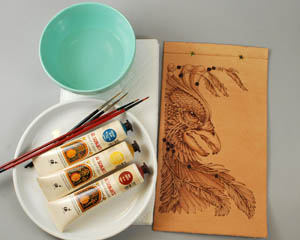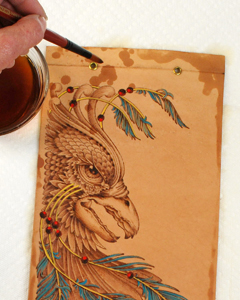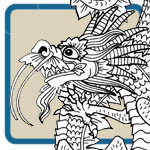Acrylic Paint on Leather
Leather is most often colored using leather dyes, acrylic paints or fabric paints all of which are permanent colors that require no finishing sealer.
Artist quality acrylics provide a truly transparent coloring that allows your wood burning work to show through their application. Cadmium yellow, cadmium red and ultramarine blue are pure color pigment and can be mixed to create every color hue that you need.
Step 1: ADDING A FEW COLOR ACCENTS
 Place a small amount of acrylic color on a palette or glazed tile. Add a few drops of clean water to each color. For this project you want to thin the colors just enough that if brushed onto news print you can both see the color work yet still be able to read the newspaper article.
Place a small amount of acrylic color on a palette or glazed tile. Add a few drops of clean water to each color. For this project you want to thin the colors just enough that if brushed onto news print you can both see the color work yet still be able to read the newspaper article.
Working one color at a time, load a #2 sable hair liner brush or #2 round with a small amount of color. Touch the tip of the loaded brush to the edge of your palette to remove the excess color from the brush’s tip.
Apply one light coat of color to all of the areas to receive that color. Allow those areas to dry for about five minutes. Apply a second coat of color to the areas if needed to intensity the color look.
I used a very limited amount of color on this project – just enough to accent a few areas while not detracting from the tonal value work of the pyrography.
Cadmium yellow – long flowing feather shafts
Medium turquoise – long flowing feather units
Cadmium red – feather beads
Step 2: STAINING THE LEATHER
 This project has been worked on a piece of distressed leather to give the finished book an aged feeling. To add to the antique look of the book cover I have randomly stained the outer edges of the leather. Real stains are seldom planned. Often you spill coffee or tea on an object or perhaps the items has picked up dirt from excessive handling over the years. As you work through the next few steps be very casual and carefree as to where your staining colors fall. Relax and have fun!
This project has been worked on a piece of distressed leather to give the finished book an aged feeling. To add to the antique look of the book cover I have randomly stained the outer edges of the leather. Real stains are seldom planned. Often you spill coffee or tea on an object or perhaps the items has picked up dirt from excessive handling over the years. As you work through the next few steps be very casual and carefree as to where your staining colors fall. Relax and have fun!
My first staining solution is ¼ cup of coffee grounds mixed with ¼ of water. Microwave this mix for about 1 to 3 minutes, not quite to boiling. Allow the mix to stand overnight. Strain the mixture through a coffee filter and set the grounds aside, we will be using the thick black coffee as the staining agent.
Fill a large round brush, sized 10 or larger, with clean water. Run the brush at random along the edges of the leather cover, saturating these areas with water. Next fill your round brush with your coffee solution and repeat the saturating step. My staining is deepest along the outer edges with several large areas of coloring near the corners.
Let these two steps dry for several moments, until the glossy shine has been lost. Then repeat these two steps until you several well developed stained areas in a rich sienna tone.
Coffee is fully transparent and will add that realistic coloration to your staining process that acrylic paints can not match. Black and green tea can also be used as staining agents as well as black walnut hulls soaked in water.
 If you want to add even more realism to the staining effect try setting a coffee cup in your coffee mixture then place the cup on your sketch book cover. The cup will leave a cup ring adding to the antique look.
If you want to add even more realism to the staining effect try setting a coffee cup in your coffee mixture then place the cup on your sketch book cover. The cup will leave a cup ring adding to the antique look.
To finish the stained, aged look of the cover I have thinned burnt umber acrylic paint with water so that the color will flow easily from my brush but not so thin that I can read a newspaper through the mixture. Fill your large round brush with the thinned burnt umber and shake it over the sketch book cover. This will cause large drops of the mix to land on the leather, adding to
the staining effect. You can also mix burnt umber acrylic paint with a smaller amount of water and use an old tooth brush to add fine splattering.
Allow your paint to dry well, at least several hours, before you begin the binding process. When your painting and staining steps are dry you will be able to see that the coffee stains the leather without leaving a halo or ring of darker color along the outer edge of the stain. The large splatter drops of burnt umber will have the halo effect.
For more great patterns to use with this free pyrography project by L S Irish visit our Asian Dragons patterns and drawings package. 